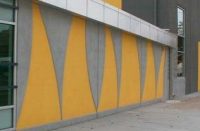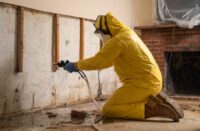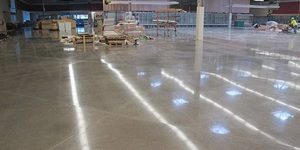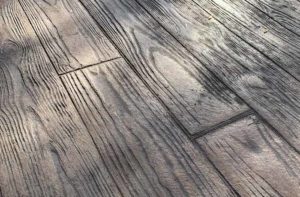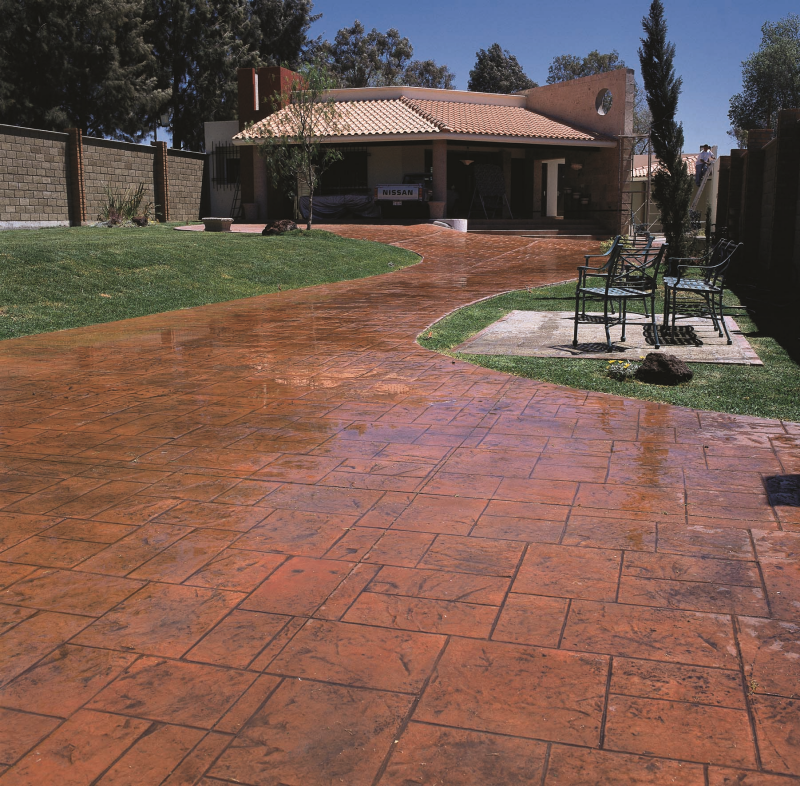
Man has decorated his home since cave-dwelling times. Using things such as clay, tree sap and dyes from berries, flowers and minerals, he turned his home into an art gallery. As time progressed, man moved from stone dwellings to mud and straw and lumber homes. Ultimately, he built homes out of brick and transformed dirt foot paths into concrete sidewalks.
Then in the mid-20th century, high-rises started to spring up worldwide. Glass and steel replaced the early 20th century red-and-yellow brick faces, but the floors remained gray. Soon, though, he felt creative and wanted to color the floors as well.
Consequently, architects, engineers and chemists put their heads together and came up with fascinating ways to decorate floors. Thanks to the ancient Greeks, polished marble and granite floors already existed. However, in the 20th century, these two items became cost prohibitive. So, engineers took up the task to come up with affordable, yet appealing floors.
They first polished gray concrete floors (now once again very popular) to create a glass or ceramic look. They added marble chips to wet concrete, and polished and terrazzo floors became the architects’ choices. At the same time, the coatings industry made advances in architectural coatings, but the entire industry revolved around alkyd paint.
Made from natural oils — like linseed and cotton seed — alkyd paints are good materials. However, they take forever to dry and aren’t resistant to UV light. In a short time, the paint deteriorates and requires repainting.
Acrylics widen the choices
Then, the painting and coating industry introduced products that contained a workhorse polymer called acrylic. Soon, acrylic paints became the choice product. Not only is acrylic an amazing polymer but it’s an exceptional film former, inexpensive and has a very high gloss. Its qualities run the gamut: UV resistant, high tensile strength, high abrasion resistance and exceptional penetrating quality. And, best of all, it dissolves in solvents as well as easily disperses in water.
Manufacturers can also cross-link acrylics with other polymers to form tough chemical- and moisture-resistant coatings and highly abrasion- and heat-resistant sealers. These coatings are ideal where hot-tire resistance is a must. Both inorganic and organic pigments can be added to the acrylic carrier to produce decorative sealers.
Our modern concrete coating needs don’t stop here. Sometimes places like warehouses, airport hangars, slaughterhouses, athletic fields, shopping malls and theme parks require abrasion-, chemical-, moisture- and weather-resistant coatings. In such cases, thermoset epoxy, polyurethane and polyaspartic coatings come in handy.
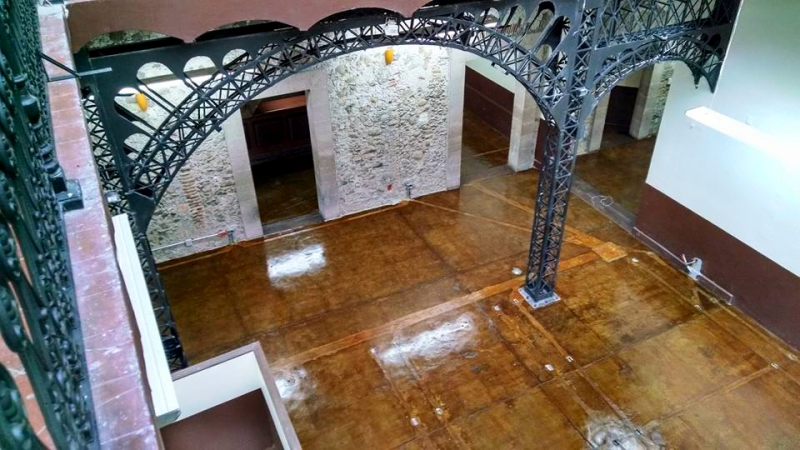
Stamped concrete emerges
In the ’70s, decorative concrete took a complete turn from traditional gray. Those in the field added color, plasticizers and polymers to concrete. They stamped it to look like brick, cobblestone, slate, flagstone and other things.
Initially they used metal stamps, but thanks to polyurethane chemistry, manufacturers developed lightweight flexible stamps. This boosted the stamped concrete industry to a multibillion industry worldwide.
Stenciling surfaces
At the same time, stenciling surfaced. Choices included cut-out plastic stencils to place on the floor. One installation technique involves using a grout spray gun to spray a special highly polymerized grout, consisting of acrylic and polyvinyl acetate polymers, over the stencil.
The polymer provided flexibility and chip-resistance to otherwise brittle grout. Upon drying, the stencil is lifted, leaving beautiful images.
Spray Deck improves pool surrounds
Spray Deck was also introduced around this time. The same material as the stenciling grout mentioned above, it’s mostly sprayed around swimming pools. A textured grout raised above the ground a few centimeters, it prevents people from slipping when they came out of a pool. It also keeps the floor a little cooler as it allows the air to circulate through the textured film.
These grouts not only contain polymers but they also have plasticizers, dispersing agents, adhesion promoters, coupling agents, alkaline-resistant colorants, fibers and waterproofing agents.
Acid stains color without colorants
Among all the methods of decorating concrete, acid staining concrete is probably the most ingenious way to color concrete. Basically, you color concrete without colorants. How can this be?
Well, concrete has phosphates, sulfates, aluminates and other minerals distributed naturally and randomly. Each reacts with inorganic acids and metal salts quite differently. Subsequently, they produce light and dark color streaks and swatches. In the end, the finished products resemble marbleized objects.
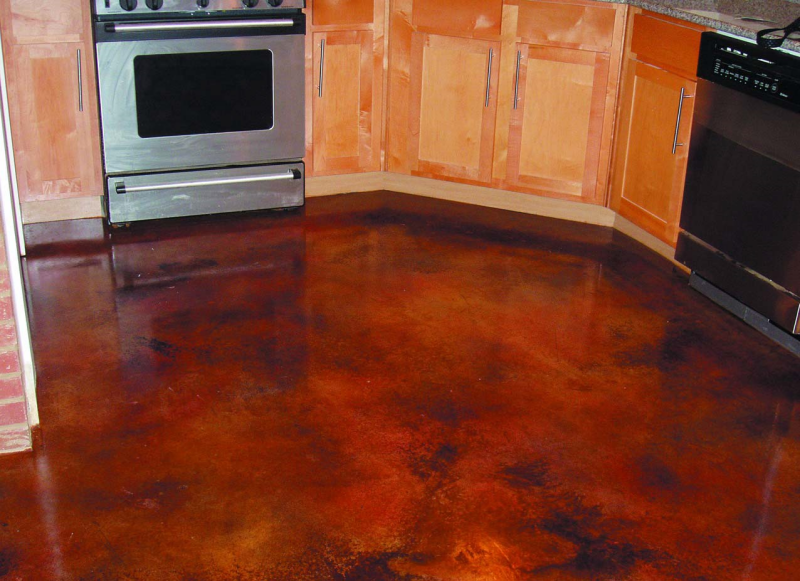
Acid stains didn’t gain much popularity because of toxicity, fumes, a messy cleanup and slow color development. But lately, they have shown further advancements as the industry works to replace inorganic acids with green botanical extracts. The industry is also working to replace toxic sodium dichromate with nontoxic chemicals.
The biggest stride in these semi-green acid stain systems involves obtaining full-color strength within two hours, not 12 hours like conventional methods. Also, you can apply them in a nonventilated area. And, most importantly, you don’t have to neutralize them.
Stucco evolves
Of course, let’s not forget stucco. No longer just lime plaster, today’s stucco contains polymers, ingredients to improve flexibility, waterproofing agents, adhesion promoters and stain-resisting agents. Each serves a specific purpose in stucco.
Concrete countertops, firepits become more popular
These two concrete items were introduced not too long ago and since then have gained high popularity. Again, the concrete used is highly polymerized and typically contains plasticizers. Some installers add glass fibers for added strength and chemical additives for stain and grease resistance.
Patches, crack repair run the gamut
Vinyl-based cement: Great for thin repairs to spalled, cracked or pitted concrete floors, driveways, sidewalks, steps or any other horizontal concrete surface. Vinyl resin mortars are light, dry fast and form a relatively strong bond to vertical or horizontal concrete surfaces.
Acrylic-fortified concrete: Used in thin patches, stucco, tile grout, small cracks in concrete surfaces and other areas that require waterproofing and strength.
Styrene butadiene rubber-based latex: These mortars/concrete are gaining popularity where special mechanical properties such as impact- and slip-resistance and ergonomics are the goals.
Epoxy crack repair agent: Epoxy crack repair kit comes as a two-pack package including epoxy and a hardener, usually polyamide. Portland cement, sand (and in some cases gravel) and a two-part epoxy are blended to form a strong cement. Epoxy reacts exothermally and rapidly with concrete forming an extremely strong, water- and chemical-resistant thermoset bond. You can also use a two-part epoxy as a concrete bonding agent for cracks without adding sand and portland cement.
Polyurethane crack repair agent: Like epoxy, polyurethane crack repair agents also come in a two-pack system including a polyol base and an isocyanate hardener. These crack repair agents are exceptionally good for basement cracks and leeks. Like epoxy, polyurethane crack repair agents can be used as is or blended with sand and cement.
Prestressed concrete hits the roads
These include bridges and highway overpass beams, columns, road barriers and concrete light poles formed under very high pressure and stress to strengthen the concrete. Steel bars and steel mesh are also inserted in the wet concrete to hold together concrete particles.
Stress adds strength to concrete as poles form by eradicating air pockets. Consequently, centrifugal forces (created by spinning concrete) compact the wet concrete, resulting in poles with very high strength.
Future of concrete looks solid
With the world population exploding and the associated pollution rising, the need for alternative habitats may rise. Can man migrate to water, living on its surface or below it? If so, mankind will require special housing to become aquatic. Subsequently, this will require completely unique concrete.
Likewise, if we colonize Mars or the moon, what type of concrete could be in use there? The ways in which concrete will need to evolve to meet the needs of man continues to unfold.


